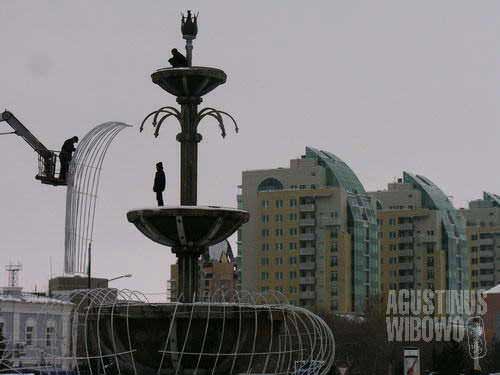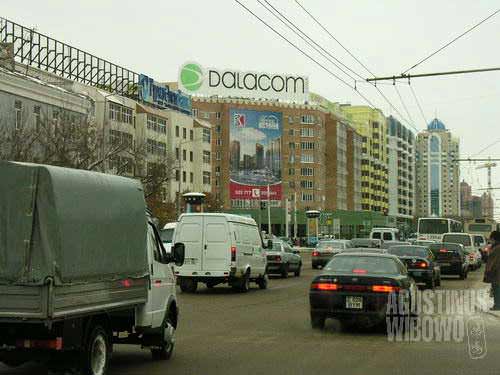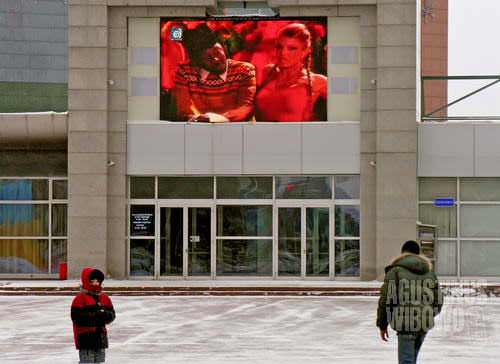Astana – A Day in the New Capital
Despite of the bitter cold due to the fierce snowfall in this sub-Arctic new capital, I forced myself to go around. As in Almaty, bus network was quite extensive in Astana. The buses were, again similar to Almaty, mostly second hand buses from Germany decorated by graffiti from the former German owners. Astana, behind the frozen bus glass window, looked completely white in my eyes.
This capital might be the most artificial city in Central Asia, even I have heard that Ashgabat, the capital of Turkmenistan – another gas and oil rich nation in the region, was comparable. Nobody would expect this place to become the capital of modern Kazakhstan. About a decade ago, Astana was just a wasteland in the middle of nowhere.
The location where Astana is, far in the north in the heartland of Kazakhstan, is known for enjoying its extreme weather in scorching hot summers and bitterly freezing winters. Nobody would decide to have a capital here. Many thought Nazarbayev was crazy with his decision. But actually he had his own calculation.
Astana, of course was not called as Astana before Nazarbayev’s decision of making it the capital of the Republic of Kazakhstan. Astana in Kazakh language simply means ‘capital’. The original name of this area was Akmola, means ‘white plenty’, because of its production of dairy products. In Soviet time, the town was renamed Tselinongrad as it was the capital of Virgin Lands projects of Nikita Khrushcev. Following the independence of Kazakhstan, just like other ex-Soviet new nations, Russian names were scrapped from the map and places got their original names.
Why the capital has to be moved to this kind of place? ‘Mola’ of ‘Akmola’ also means ‘grave’, that Akmola was said to be the political grave of Nazarbayev due to his maneuver. It was also the reason why Akmola was renamed to Astana.
Astana, was founded to make Kazakhstan closer to Russia. The original capital, Almaty, was far in the south, just next to the border with Kyrgyzstan – a small country that has no economical interest for the ‘modern’ Kazakhstan, and as Nazarbayev claimed, Almaty was vulnerable to earthquakes. Anyway, it was an unchanged fate. Capital of Kazakhstan is Astana.
Astana can be said just started its life in end of 20th century after the decree of new capital from the president. It’s a new founded town. Small and artificial. Seeing a modern city in the middle of green steppe (complete grey and white in wintertime) is an experience. It was an instant conversion from a neglected town to be a rich country capital. Of course, the capital cannot be built in a night. Instead of building modern buildings, you can notice in the downtown area, that the rows of buildings have nice painting at the side facing the main road, and ugly broken walls at the other side.
The landmark of Astana is the Beibitshilik Square which is surrounded by parliament, government offices, some embassies, and shopping malls. Russia was among the pioneer of moving its embassy to Astana, while most other countries still prefer to stay in friendlier Almaty. The Sime Tempore Mall, supposed to be one of the most modern one in the capital, is just a small shopping mall, even smaller compared to those of Almaty. But for sure, the glittering porcelain tiles and rows of luxurious jewelry shops offered high class shopping.
Maybe I came to Astana at the wrong time. The temperature was freezing even during the day, as sun was not visible at all. Only white. As pale as my mood in wandering the new town. The newer part of the city was built at the southern bank of Ishim River, but visible for me just unfinished constructions of medium-height buildings. The capital was still building itself. The construction of the new capital, the heartland of modern Kazakhstan, was still in process.
I have learnt some fantastic projects to be held in Astana. As we knew, this capital suffered extreme temperatures in a year. The rich country now was planning to finish a project of ‘Indoor Capital’, the first one in the world. The city will be covered by transparent tents, hung from the sky and resemble a plastic tent city. This would enable Astana inhabitants to walk around the town without get burnt under 40 degree summer heat and without get frozen under -40 degree winter freeze. The idea of making tent to cover a city was indeed combination of innovation from modern age, financial power from oil wealth, and old nomadic tradition of living under tents.
With huge number of middle class population as well as its isolated location from anywhere in Kazakhstan, no wonder price in Astana was very high. Accommodation price reached astronomical numbers. Here, people said they were poor if they earned less than 150 dollars (compared to the average income of 500 dollars per month, yes it was not much. But remember, in Kyrgyzstan the minimum wage in Bishkek according to government rate was only 4 dollars per month).
And I had no choice, but to spend the night in waiting hall of the train station, pretending as a passenger waiting for the arrival of international train from Moscow. I tried to laid my head on the benches in the comparatively warmer hall, but every 15 minutes at least a police came and kicked the benches so that sleeping passengers get reminded: “This is not an accommodation option!”
Astana was the first place to make me feeling as a homeless. I remembered a Chinese philosopher saying, the art of traveling was when you lost yourself. I lost my identity as an Avgustin here. I was nobody in Astana. And this brought me much deeper contemplation, during difficult time with train station police who kept waking me up from my mental journey.











Leave a comment